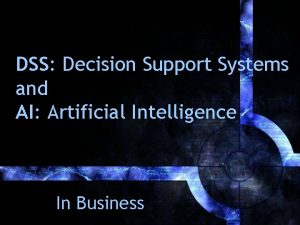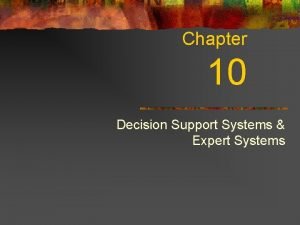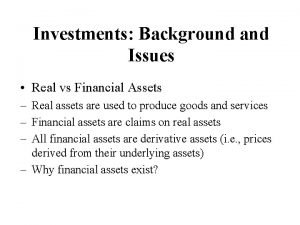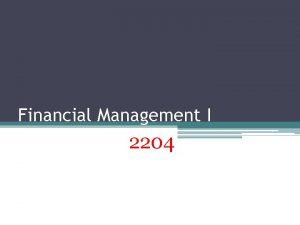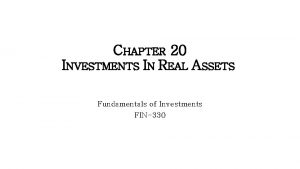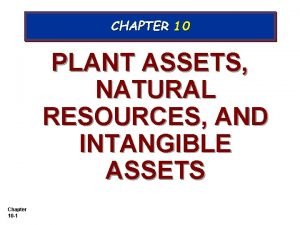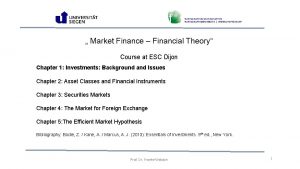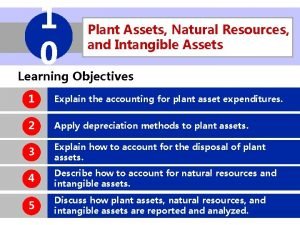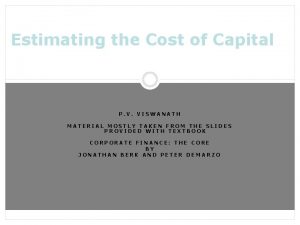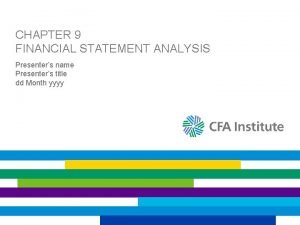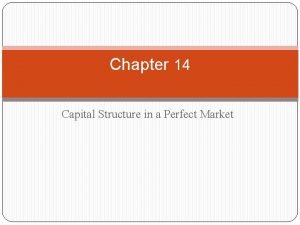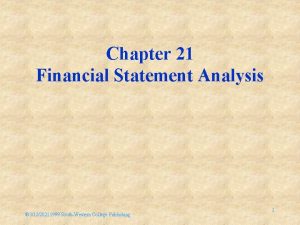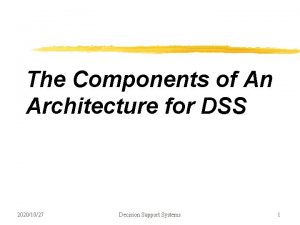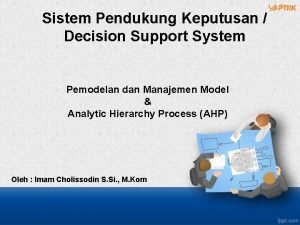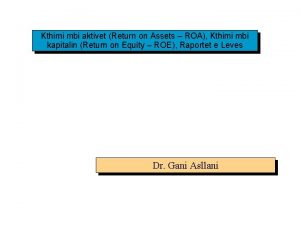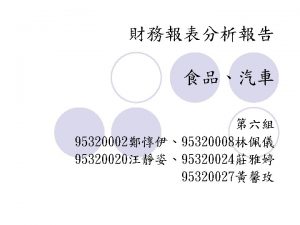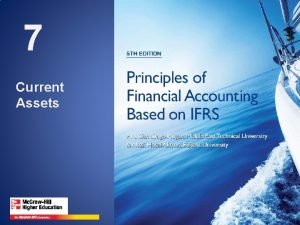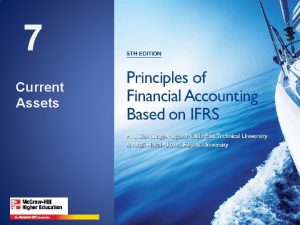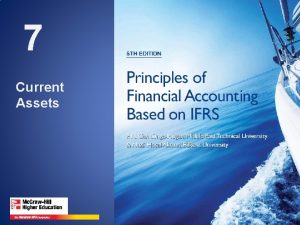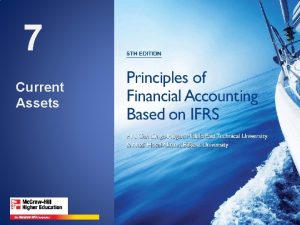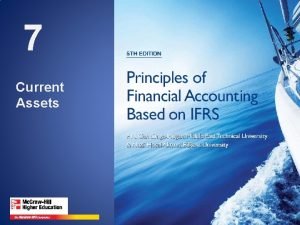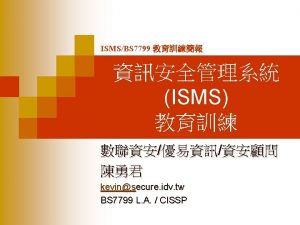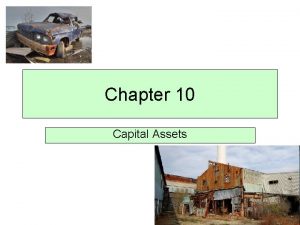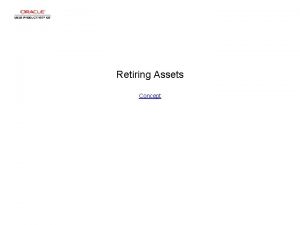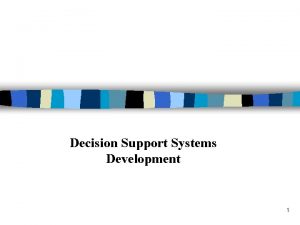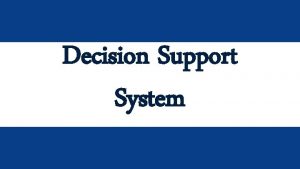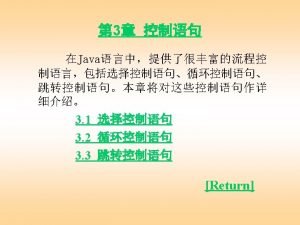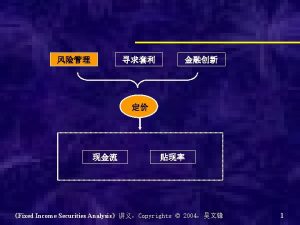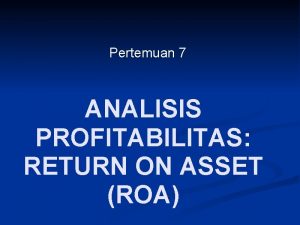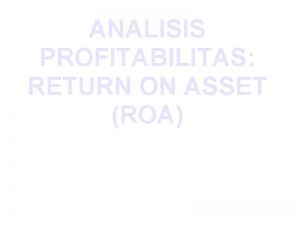Decision Support System for Return On Assets ROA




















- Slides: 20

Decision Support System for Return On Assets (ROA) Decision in Mudharabah, Musyarakah and Murabahah Using Analytic Network Process (ANP) Method (Case Study: Bukopin Syariah Bank Bekasi) Name : Harun NIM : 2018 1145 20019 Program Pascasarana S 2 KEUANGAN SYARIAH INSTITUT TEKNOLOGI DAN BISNIS AHMAD DAHLAN JAKARTA S 2 KEUANGAN SYARIAH 2020

BACKGROUND OF PROBLEMS � Problems which according to the author really need to be investigated, namely: a) Murabahah contract is much in demand by consumers / customers in the transaction compared to Mudharabah and Musyarakah contracts. What caused the customer to make that decision? As a result of the large number of customers making Murabahah contracts, the products offered in the form of Mudharabah and Musyarakah contracts are less desirable. a) Return on Assets (ROA) is a ratio to measure whether or not a bank is in carrying out its activities. The results obtained from Murabahah contract transactions are more dominant in providing income for Return on Assets (ROA), while the results obtained from Mudharabah and Musyarakah contract transactions do not provide significant results. ITB-AD 2020

What causes the customer to make the decision to use the Murabahah contract in the transaction compared to the Mudharabah, Musyarakah contract, thereby increasing the potential Return on Assets (ROA) at Syariah Bukopin Bank Bekasi? Formulatio n Of The Problem Why are Mudharabah and Musyarakah contracts less attractive to customers, so there is a potential for a decrease in Return on Assets (ROA) at Syariah Bukopin Bank Bekasi? What are the factors that make customers different in making a decision to choose a Murabahah, Mudharabah and Musyarakah contract at Syariah Bukopin Bank Bekasi?

LITERATURE REVIEW AND BASIC THEORY A. Return On Assets (ROA) The Return on Assets (ROA) ratio is used to measure bank profitability because Bank Indonesia as a bank supervisor and banking supervisor prefers the profitability of a bank as measured by assets whose funds are mostly from public savings funds B. . Mudharabah is a business cooperation agreement between two parties where the first party (shohibul maal) provides all (100%) of capital, while the other party becomes the manager of the business C. Musyarakah Musharakah financing is a partnership in which two or more entrepreneurs work together as business partners in business. Each party includes their capital and participates in managing the business. Profits and losses will be divided based on the percentage of equity investment D. Murabahah is the sale and purchase of an item by confirming its purchase price (acquisition price) to the buyer and the buyer pays it at an excess price (margin) as profit according to the agreement of the parties ITB-AD 2020

RESEARCH METHOD Types of research 1. The research used in this thesis is a qualitative analysis research, which aims to capture a value or view represented by sharia experts and practitioners about the Mudharabah, Musyarakah, Murabahah and ROA contracts at Syariah Bukopin Bank Bekasi. 2. The analytical tool used is the Analytic Network Process (ANP) method and is processed using "Super Decision" software. Population, Samples Techniques and Sampling The number of respondents in this study consisted of five people, 1 expert and 4 practitioners with competent considerations. As for the valid respondents' requirements in the Analytic Network Process (ANP), they are people who are experts or experts in their fields. Therefore, the respondents chosen in this survey are Islamic economic experts / researchers and practitioners working at Syariah Bukopin Bank). The sampling technique is done by the method of purposive sampling, which is a method of sampling based on certain considerations, especially considerations given by a group of experts or experts ITB-AD 2020

Data collection technique Phase 1: Model Contruction literature review, Indeept interview, questionnaire Model Construction Phase 2: Model Quantification Validation/ Model Confirmation, preparation of the ANP questionnaire Phase 3: analysis of results Data Analysis, Validation of Result, Interpretation of Result ITB-AD 2020

a) Model Construction The construction of the Analytic Network Process (ANP) model was compiled based on literature review in theory and empirically and gave questions to Mudharabah, Musyarakah, Murabahah experts and practitioners as well as through in-depth interviews to examine information more deeply to obtain actual problems. b) Model Quantification The quantification stage of the model uses the questions in the Analytic Network Process (ANP) questionnaire in the form of pairwise comparison between elements in the cluster to find out which of the two has greater influence (more dominant) and how big the difference is through the numerical scale 1 -9. The assessment data is then collected and inputted through the super decision software to be processed so as to produce output in the form of priority and super matrix. The results of each respondent will be inputted on a separate Analytic Network Process (ANP) network. c) Synthesis and Analysis a. Geometric Mean To determine the results of individual assessments of the respondents and determine the results of opinions in one group carried out an assessment by calculating the geometric mean b. Rater Agreement Rater agreement is a measure that shows the level of agreement (agreement) of the respondents (R 1 -Rn) to a problem in one cluster. The instrument used to measure the rater agreement is Kendall's Coefficient of Concordance (W; 0 <W≤ 1). W = 1 shows perfect compatibility ITB-AD 2020

ANALYSIS AND DISCUSSION Identification of Problems a) The contract aspect 1) Mudharabah is a contract of cooperation between the owner of the funds (Shahibul Maal) and the entrepreneur (mudharib) to conduct a joint business. The profits obtained are divided between the two with a ratio of agreed ratio beforehand. 2) Musyarakah is a partnership in which two or more entrepreneurs work together as business partners in business. Each party includes their capital and participates in managing the business. Profits and losses will be divided based on the percentage of equity investment. 3) Murabaha is selling an item by confirming its purchase price to the buyer and the buyer pays it at a price more as profit. b) Aspect of the Problem 1) Lack of commitment, lack of commitment / consistency of customers in making contract transactions, namely Mudharabah, Musyarakah and Murabahah. 2) Lack of understanding; the lack of understanding of issuers which contributed to the lack of interest in issuing sukuk. 3) Lack of knowledge; namely the lack of knowledge possessed by customers. In this case, the customer does not yet know the characteristics and advantages of the contract which are Mudharabah, Musyarakah and Murabahah. 4) Averse to risk; one of the risks considered by customers is the risk in dealing with contracts, namely Mudharabah, Musyarakah and Murabahah. Customers do not want to take a lot of risk by making transactions with the contract, so they prefer the best for the customer enough that the contract has been used first. c) Aspect of Solution The alternative solutions that can be done include: Fundamental Solutions 1) Conduct intensive, directed and integrated socialization. 2) Conducting product innovations in terms of the type of contract and time period. 3) Marketing, especially promotional activities.

Pairwise Comparison ITB-AD 2020

Figure 3: Geometric Priority Mean Wp=0, 316 We=0, 834 W=0, 154 Geometric Mean Akad Solution Problem 0 Total Expert Practitioners 0, 1 0, 2 Problem 0, 541 0, 641 0, 568 0, 3 Solution 0, 4 0, 374 0, 412 0, 316 0, 5 0, 6 Akad 0, 219 0, 187 0, 236 0, 7 The results of the experts show that the problem and the solution are the two most important aspects, with a substantial rater agreement (We = 0. 834). As for practitioners, the most important aspect is the aspect of problems and solutions, with a lower rater agreement value (Wp = 0. 316). Overall, as the results of the experts show the problem aspect as the most important aspect that must be considered from the problem of the contract development, followed by the solution aspect and the contract aspect, with the rater agreement level (W = 0. 154).

Figure 4: Priority for Contracts Aspects Contract Aspects Wp=0, 677 We=0, 219 W=0, 195 Murabahah Musyarakah Mudharabah 0 Total Expert Practitioners 0, 1 0, 2 Mudharabah 0, 446 0, 356 0, 52 0, 3 0, 4 0, 5 0, 6 Musyarakah 0, 214 0, 439 0, 338 0, 7 0, 8 0, 9 Murabahah 0, 819 0, 787 0, 812 In the aspect of the problem, as shown in Figure 4. 3, both experts and practitioners agree that there is indeed a crucial problem in the contract aspect, with a high rater agreement value of (Wp = 0. 677) and (We = 0. 219). The thing that is of concern to both is the lack of understanding and commitment. Likewise as a whole, the next most crucial problem is the Mudharabah and Murabahah contracts with a high rater agreement value of (W = 0. 154).

Figure 5: Priority Aspects of the Problem Aspects Wp=0, 894 We=0, 726 W=0, 137 Risk Level Lack of Knowledge Lack of understanding lack of commitment Expert Practitioners Total 0 of 0, 05 0, 1 0, 2 Lack 0, 25 of 0, 3 lack Lack 0, 15 of commitment understanding Knowledge 0, 36029 0, 38796 0, 17098 0, 34028 0, 36794 0, 15096 0, 18025 0, 12765 0, 09763 0, 35 0, 45 Risk Level 0, 16084 0, 14082 0, 10231 The experts argue that the most important problem lies in terms of the level of risk with value (We = 0. 726). Whereas practitioners believe that the level of risk and lack of customer knowledge remains a major problem with a greater rater agreement value (Wp = 0. 894). Overall, the level of risk is a problem of more concern than the opinions of experts and practitioners with (W = 0. 137).

Figure 6: Priority for Solution Aspects Solution Wp=0, 389 We=0, 726 W=0, 218 Total Expert Practitioners 0 Sosialization Marketing Produck Inovation 0, 1 0, 2 Practitioners 0, 48362 0, 27385 0, 24245 0, 3 Expert 0, 4 0, 20938 0, 25949 0 0, 5 0, 6 Total 0, 7 0, 593 0, 158 0, 264 The aspect of solutions the experts consider that the most problematic aspect is product innovation with a rater agreement value We = 0. 726. Neither is based on the results for practitioners that product innovation is also the most important, followed by socialization and promotion with a higher rater agreement value of (Wp = 0. 389). Overall, experts and practitioners stated that product innovation was also the most important followed by socialization and promotion with a relatively low rater agreement (W = 0. 218) meaning that the answers of respondents tended to be the same.

Summary of Results This study explains that the results show the level of appropriateness of aspects among respondents both experts and practitioners as a whole is relatively low, with a coefficient value (W = 0. 137). However, a greater level of concordance among respondents to experts was (We = 0. 834) compared to the level of concordance between practitioners (Wp = 0. 316). The experts have the highest level of conformity in the aspect of solutions that is product innovation of (We = 0. 726). In detail, the expert agrees that the issue of risk level becomes a problem that concerns more than the opinion of experts and practitioners with (W = 0. 137). Product innovation is also the most important, followed by socialization and promotion with a higher rater agreement value (Wp = 0. 389). Overall, all respondents had the highest level of appropriateness in the aspect of solutions, namely product innovation (W = 0. 218) and the level of risk became a problem of more concern than the opinions of experts and practitioners with (W = 0. 137).

Figure 7: Priority Geometric Mean ASPECT Problem Solusi Akad 0 ASPEK 0, 1 Akad 0, 2 0, 315 0, 3 0, 4 Solusi 0, 5 0, 726 0, 7 Problem 0, 8 0, 9 0, 812 The mean geometric results of all respondents show priority order of aspects, i. e. 1) Problem Aspects; 2) Solution aspects; 3) Contractual Aspects. The following results are a comparison of all elements contained in the problem aspect.

Figure 8: Priority Problem Description 0, 9 0, 8 0, 7 0, 6 0, 5 0, 4 0, 3 Mudharabah 0, 2 Musyarakah 0, 1 Murabahah ke tin g n M ar ov a tio io n od uc k In iz al si Pr So k is R at Le v el dg e le ow di ng of Kn st an er La ck nd of ck La La ck of U C om m itm en t 0 Based on the results above, it can be seen the contribution of each element in each aspect. If the elements of the problem in an effort to improve the development of Mudarabah, Musyarakah and Murabahah schemes as a whole are combined in order to increase Return On Assets (ROA), then the following priority sequence will be generated: a) Lack of commitment / commitment (lack of commitment) b) Lack of understanding c) Lack of knowledge d) Risk level e) Intensive, directed and integrated socialization f) Product innovation in all contracts and time periods g) Marketing, especially promotional activities

CONCLUSION This research shows the results that the problems that arise consist of 3 important aspects, namely contract, problem and solution. The issues raised in an effort to increase Return on Assets (ROA) in Mudharabah, Musyarakah and Murabahah contracts as a whole are outlined, resulting in a priority order: 1) lack of consistency / commitment (lack of comitment), 2) lack of understanding (lack of understanding), 3) lack of knowledge, 4) risk level, 5) Socialization 6) Product innovation 7) Marketing (promotion). This study explains that the results show the level of appropriateness of aspects among respondents both experts and practitioners as a whole is relatively low, with a coefficient value (W = 0. 137). However, a greater level of concordance among respondents to experts was (We = 0. 834) compared to the level of concordance between practitioners (Wp = 0. 316). The experts have the highest level of conformity in the aspect of solutions that is product innovation of (We = 0. 726). In detail, the expert agrees that the issue of risk level becomes a problem that concerns more than the opinion of experts and practitioners with (W = 0. 137). Product innovation is also the most important, followed by socialization and promotion with a higher rater agreement value (Wp = 0. 389). Overall, all respondents had the highest level of appropriateness in the aspect of solutions, namely product innovation (W = 0. 218) and the level of risk became a problem of more concern than the opinions of experts and practitioners with (W = 0. 137).

References 1. Afif, Muhammad Amirillah. 2010. Efisiensi Perbankan Syariah Di Indonesia, TESIS, Magister Ilmu Ekonomi dan Studi Pembangunan, Universitas Diponegoro Semarang. 2. Bank Syariah Bukopin. 2018. Laporan Tahunan 2018, Jakarta 3. Kasmir. (2010). Pengantar Manajemen Keuangan. Jakarta: Kencana Prenada Media Group. 4. Nurhasanah, Ayu. 2005. Pelaksanaan Peranian Pembiayaan Dengan Prinsip Bagi Hasil (Al-Mudharabah) Pada Bank Syariah Mandiri Cabang Pontianak. Tesis. Magister Kenotariatan, Universitas Diponegoro, Semarang 5. Ernomo, Meliana. 2013. Analisis Metode Pengakuan Keuntungan Pembiayaan Murabaha pada PT. Bank Syariah Mandiri. Skripsi. Universitas Islam Negeri Syarif Hidayatullah, Jakarta 6. Ascarya, 2011. The Development Of Islamic Financial System In Indonesia And The Way Forward. Paper to be published as Occasional Paper, Bank Indonesia. 7. Khaira, Fathya Ummah dan Edy Suprapto. 2015. Faktor-Faktor yang Mempengaruhi Profitabilitas Pada Bank Muamalat Indonesia. Jurnal Ekonomi dan Perbankan Syariah, Vol. 3 No. 2, Oktober 2015 8. Ubaidillah. 2016. Analisis Faktor-Faktor yang Mempengaruhi Profitabilitas Bank Syariah Di Indonesia. Jurnal Ekonomi Islam El-Jizya, Vol. 4 No. 1 9. Nur, Anisa Rahmah. 2018. Analisa Pengaruh CAR, FDR, NPF dan BOPO Terhadap Profitabilitas Return On Assets (ROA) Pada Bank Syariah Mandiri Taun 2013 -2017. Skripsi. IAIN Purwokerto 10. Antonio, Muhammad Syafi’i. 2010. Bank Syari’ah dari Teori Ke Praktek. Jakarta: Gema Insani Press 11. Muhammad. 2005. Manajemen Pembiayaan Bank Syariah. Yogyakarta: UPP YKPN 12. Peraturan Bank Indonesia Nomor: 8/21/PBI/2006 tentang Pembiayaan Musyarakah 13. Harun. 2018. Pengaruh Musyarakah dan Murabahah Terhadap Pendapatan Bank Pembiayaan Rakyat Syariah (BPRS) Patriot Bekasi Tahun 2009 -2017. Skripsi. Institut Bisnis Muammadiyah Bekasi 14. Sugiono. 2010. Metode Penelitian Tindakan Kelas Pendekatan Kuantitatif, Kualitatif, dan R&D, Bandung: Alfabeta 15. Anwar Sanusi, 2011, Metode Penelitian Bisnis, Salemba Empat, Jakarta 16. Jonathan, Sarwono. 2006. Metode Penelitian Kuantitatif dan Kualitatif. Yogyakarta: Graha Ilmu 17. Hasan, M. Iqbal. 2002. Pokok-pokok Materi Metodologi Penelitian dan Aplikasinya. Bogor: Ghalia Indonesia 18. Saaty, T. L. 2004. Fundamental of the analyitic network process dependence and feedback in decision-making with a single network. Pittsburgh : RWS Publication ITB-AD 2020

THANK YOU ITB-AD 2020

 Objectives of decision making
Objectives of decision making Financial management process
Financial management process Dss vs expert system
Dss vs expert system An expert system is
An expert system is Decision categories
Decision categories Real and financial assets
Real and financial assets Real assets vs financial assets
Real assets vs financial assets Real assets vs financial assets
Real assets vs financial assets The three plant asset disposal methods
The three plant asset disposal methods Plant assets natural resources and intangible assets
Plant assets natural resources and intangible assets Financial assets examples
Financial assets examples Plant assets, natural resources, and intangible assets
Plant assets, natural resources, and intangible assets Unlevered return on assets
Unlevered return on assets Return on average equity
Return on average equity Operating return on assets
Operating return on assets Unlevered beta
Unlevered beta Return on assets
Return on assets Return on assets
Return on assets Voyage estimating decision support system
Voyage estimating decision support system Dss architecture components
Dss architecture components Contoh decision support system adalah
Contoh decision support system adalah



